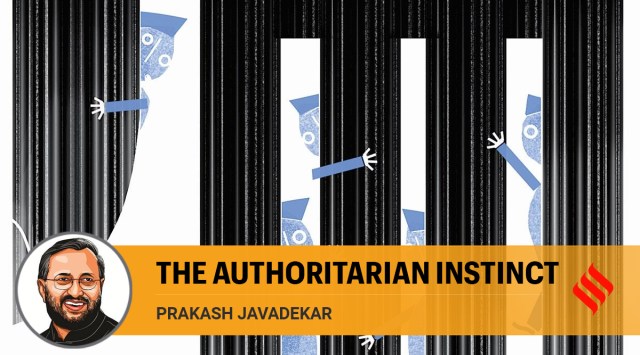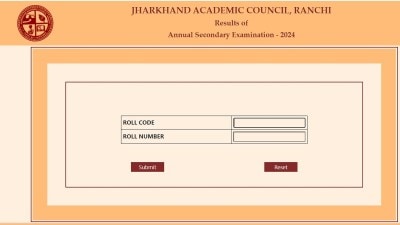- India
- International
The qualities that led to Emergency are alive and kicking in Congress
Prakash Javadekar writes: Its dictatorial instincts have not gone anywhere, even when the party has been reduced to its lowest ebb.
 The dictatorial instincts of the Congress have not gone anywhere, even when it has been reduced to its lowest ebb. (Illustration: C R Sasikumar)
The dictatorial instincts of the Congress have not gone anywhere, even when it has been reduced to its lowest ebb. (Illustration: C R Sasikumar)It has now been 46 years since the darkest day Indian democracy has ever seen — the beginning of Emergency. The Emergency and its withering assault on democratic principles is a black day not only for Indians but for anyone who values the rule of law, rule of the people and constitutionalism.
There were many evils inflicted upon our nation during the Emergency. The blow it dealt to our Constitution and our institutions is too well documented to be repeated here. Let alone other fundamental rights, even the “right to life” was taken away from the people.
However, while many of these facts are well established, the problem is that the mentality that led to the imposition of Emergency still persists in the topmost echelons of the Congress party.
When India’s first Prime Minister Jawaharlal Nehru dismissed governments in Kerala and Punjab, this mindset was there for everyone to see. During a debate on India and China in the 1960s, when questioned about leadership, no less a figure than the Prime Minister himself said that questioning the preparedness against China would be akin to lowering the morale of the nation. Privileging one family over others, too, began with Nehru, when Indira Gandhi was made Congress President in 1959.
Time and again, many national and regional leaders who did not toe the Nehru-Gandhi dynasty’s line were humiliated and the party became the sole property of one family. Be it Morarji Desai, K Kamaraj, Atulya Ghosh, Charan Singh, Devi Lal, Babu Jagjivan Ram, people were pushed aside to make way for one-family rule over the party, which eventually made way for an attempt at one-party rule over the country.

Everyone knows how Sitaram Kesri was forced to make way for Sonia Gandhi and, later, how Jitendra Prasad was targeted for fighting the election for Congress president, though he had every right to contest for the post. In the same vein, every young leader in the Congress who could be seen as a competitor to Rahul Gandhi is being hounded out.
A hunger for the concentration of power has ingrained a disdain in the Nehru-Gandhi family for other democratically elected leaders. When Congress governments were at the Centre, President’s Rule was imposed on states a staggering 80-plus times. A corollary of this meant that Raj Bhavans were used as de facto Congress party headquarters. This has happened even as recently as the UPA era.
Even at the Centre, the Congress has always had a “power behind the throne approach”, which did not allow a single coalition government that had their “outside support” to finish its term.
The rot perpetuated by Congress’s hunger for power spread far and wide, touching even the judiciary. It was the Congress under Indira Gandhi that called for a “committed judiciary” and even went about creating it. Superseding judges to place pliable people, the punishment of judges like Justice H R Khanna who failed to fall in line, and the case of Baharul Islam who switched between political posts in the Congress and judicial appointments with no compunction are just a few examples. In the Sonia Gandhi era, Chief Justices were randomly transferred, which the late Arun Jaitley described as a calculated attempt to create terror amongst the judges.
The dictatorial instincts of the Congress have not gone anywhere, even when it has been reduced to its lowest ebb. Rahul Gandhi tried to impeach a Chief Justice simply because he would not entertain the Congress’s attempts at running a vile political agenda through courts.
Anyone who disagrees with the de facto leadership of a serial electoral failure such as Rahul Gandhi is sidelined, like the case of the recent “G-23”. The Nehru-Gandhi family uses internal subterfuge as a way of cutting down to size strong regional leaders of its own party in Punjab and Rajasthan.
In stark contrast to the Congress’s shenanigans is Prime Minister Narendra Modi who puts the nation above everything. This stems from the BJP’s political tradition that gave up power but did not go against constitutional principles.
While the Congress puts power over everything else, PM Modi pulled out of a coalition in Jammu and Kashmir because the coalition partner was stonewalling the DDC polls. This was a case of putting grassroots democracy above political power.
It is under the leadership of PM Modi that a milestone in cooperative federalism has been created with the GST Council, where states are accorded importance. Rules have been amended to ensure the Leader of Opposition gets to attend key meets involving CBI appointments.
The Congress’s treatment of political opponents is well known. Led by Sonia Gandhi, they called a towering figure like Atal Bihari Vajpayee the worst names. On the other hand, PM Modi’s emotional speech and tears at the exit of Ghulam Nabi Azad from Parliament is an indicator of the BJP’s values.
Key differences between the authoritarian, power-hungry instincts of the Congress and the democratic outlook of anti-Congress forces should not be forgotten.
The characteristics in the Congress that led to the imposition of Emergency are alive and kicking. It’s just that they don’t have a shot at political power at the Centre, and it is better that way.
This column first appeared in the print edition on June 26, 2021 under the title ‘The authoritarian instinct’. The writer is Union Minister of Environment, Forest & Climate Change; Information & Broadcasting; and Heavy Industries & Public Enterprises.
EXPRESS OPINION
More Explained
Apr 19: Latest News
- 01
- 02
- 03
- 04
- 05










































